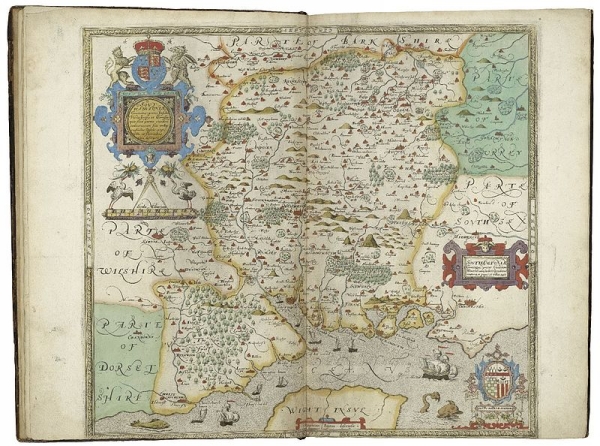Boarding @ Home: Day 107/84: Dorset[shire], [Southampton]shire, Wiltshire, Royal Berkshire, Oxfordshire to Northamptonshire! ... and Ridings ....
Back to Milton requires crossing five counties … There's an ABC [Association of British Counties] campaign to preserve the 'ancient' county names and borders despite all the changing local governing authorities. The division of England into shires including Dorsetshire, later known as counties, began in the Kingdom of Wessex in the mid-Saxon period many of those Wessex shires representing previously independent kingdoms. With the Wessex conquest of Mercia in the 9th and 10th centuries the system was extended to central England. At the time of the Domesday Book in 1086 Northern England comprised Cheshire and Yorkshire with the north-east being unrecorded. The remaining counties of the north, Westmorland, Lancashire, Cumberland, Northumberland and Durham were established in the 12th century with Rutland first recorded as a county in 1159.

Here's fact for us as we go travelling back to Milton Malsor in Northamptonshire across several county borders! Yes, Hampshire was dubbed Southamptonshire on Saxton's Atlas above in 1579 and still continued on some Victorian maps! As we leave Dorsetshire it's our first crossing, briefly, capital ancient Winchester. It gives us the only dualled carriageways. Then we're into Wiltshire before back again into Hampshire. Next we are reaching the Royal County of Berkshire - royal only since the last century because it includes Windsor Castle but we pass by Newbury. From, there we pass across Oxfordshire before reaching Northamptonshire.
… but back to Dorsetshire. The first human visitors to Dorset were Mesolithic hunters from around 8000 BC. The first permanent Neolithic settlers appeared around 3000 BC and were responsible for the creation of the Dorset Cursus - a 6.5 miles monument for ritual or ceremonial purposes. From 2800 BC onwards Bronze Age farmers cleared Dorset's woodlands for agricultural use and Dorset's high chalk hills provided a location for numerous round barrows. During the Iron Age, the British tribe known as the Durotriges established a series of hill forts across the county—most notably Maiden Castle which is one of the largest in Europe. The Romans arrived in Dorset during their conquest of Britain in AD 43 and Maiden Castle was captured by a Legion under the command of Vespasian after which the Roman settlement of Durnovaria was established nearby. Bokerley Dyke, a large defensive ditch built by the county's post-Roman inhabitants near the border with modern-day Hampshire, delayed the advance of the Saxons into Dorset for almost 150 years. However, by the end of the 7th century Dorset had fallen under Saxon control and been incorporated into the Kingdom of Wessex. The Saxons established a diocese at Sherborne and Dorset was made a shire with borders that have changed little since. In 789 the first recorded Viking attack on the British Isles took place in Dorset on the Portland coast, and they continued to raid into the county for the next two centuries. After the Norman Conquest in 1066, feudal rule was established in Dorset and the bulk of the land was divided between the Crown and ecclesiastical institutions. The Normans consolidated their control over the area by constructing castles at Corfe, Wareham and Dorchester in the early part of the 12th century. Over the next 200 years Dorset's population grew substantially and additional land was enclosed for farming to provide the extra food required. The wool trade, the quarrying of Purbeck Marble and the busy ports of Weymouth, Melcombe Regis, Lyme Regis and Bridport brought prosperity to the county. However, Dorset was devastated by the bubonic plague in 1348 which arrived in Melcombe Regis on a ship from Gascony. The disease, more commonly known as the Black Death, created an epidemic that spread rapidly and wiped out a third of the population of the country.
The Ridings of Yorkshire … No Wills familial county comments can ignore the origins of settlement in Yorkshire, birthplace of the Prestoungranges of Ilkley and the Baron of Dolphinstoun, by the Celtic Brigantines and Parisii [also settled in Paris!] around 500 BC; and then by the conquering Romans in 57 AD … but that word Yorkshire Riding comes from Vikings invaders … and has nothing to do with riding a horse anywhere. It comes from their word threthingr which translates as a third part - whence East, West and North … but not South! South Yorkshire only emerged in 1974. Eboracum [York today] was founded in 71 AD by the Romans its name derived from the Celtic word for yew tree!
… and it's also National Day for Fathers taking Daughters for a Walk. Our WhatsApp Groups have been replete with just that reality throughout lockdown, not least on Ilkley and other West Riding moors.

Published Date: July 7th 2020
|





